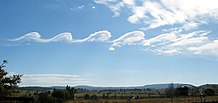Kelvin-Helmholtz instability
The Kelvin-Helmholtz instability , or KHI , is the name given to the growth of small disturbances in the shear layer of two fluids with different flow velocities .
Illustrative examples are the waves on a lake during a storm or the curling smoke of an incense stick in an otherwise quiet room.
phenomenology
When weather may phenomenon the Kelvin-Helmholtz instability in strange clouds are seen individually or in groups similar looking at the sky can be seen. They are created by a turbulence between two layers of air lying on top of one another , which move at different speeds and / or directions . Similar to when wind blows over water, waves arise at the boundary layer , with parts of the mostly humid lower air layer being whirled up so far that the dew point is not reached and clouds are formed.
Physical interpretation
Far from the boundary layer, the flow velocities are constant. Close to the boundary layer, however, an air element must move faster over the wave hump than an air element further away (similar to an airfoil ). According to Bernoulli's equation , the pressure above the wave is lower than in the surrounding area due to the higher wind speed; as a result there is a force pulling the crest of the wave up. The situation is analogous in a wave trough: the air flows more slowly over the surface of a wave trough than in the surroundings, so the ambient pressure is locally higher; the wave trough is pushed down.
theory
A simple model for the Kelvin-Helmholtz instability can be obtained by answering the following question: Given a flow over a boundary layer, under which conditions is this boundary layer stable against small disturbances?
Fault calculation
So, given a liquid of density , which moves horizontally with speed over a liquid of density . Designate a coordinate along the shear layer and the coordinate at right angles to it. Now consider a small disturbance along the shear layer and designate it with . The associated disturbance of the pressure can be described with and that of the velocity field with .
The print field can now be written as
and the speed field as
in which
- denotes the Heaviside function and
- or the unit vector in the x or y direction.
These two disturbances are now substituted in the simplest form of fluid dynamic equations, namely in the Euler equations for incompressible fluids . The incompressibility equation is
With
- the Nabla operator ( is the divergence of the speed)
and the Euler equation
With
- the gradient of the pressure.
Used there you get for the disturbed sizes
and
These two equations yield the Laplace equation for the perturbed pressure
Now you are looking for a wave mode that decreases exponentially with the distance from the interface . From the Laplace equation we conclude that the pressure must be:
With
- the angular frequency and
- the circular wavenumber .
Next one substitutes this result in the perturbed Euler equations. You get
- For
and
- for .
Now the boundary conditions must still be met: the vertical component of the disturbance and the pressure must be constant at the shear layer. This results in the following condition:
- directly above the shear layer :
and
- directly under the shear layer :
A connection between the density of the liquids, their relative speed and the wave modes can be established from this:
If you solve this equation , you get a dispersion relation for the linear Kelvin-Helmholtz modes:
Temporal growth
If one moves along the surface with the speed , the following results for the speed of the upper liquid:
- .
The disorder now develops as follows:
Spatial growth
See also
Web links
- Internship documents at gwdg (PDF file; 675 kB)
- amath.washington.edu: animated example ( Memento from August 4, 2010 in the Internet Archive )
- umich.edu: Kelvin-Helmholtz instability - temporal snapshots
- There are cloud photos: here
- SPIEGEL ONLINE: Weather phenomenon: Monster waves over an American city - Kelvin-Helmholtz waves on February 2, 2012 over Birmingham (Alabama)











































![k = {\ frac {\ omega} V} \ left [1 \ pm i \ cdot {\ sqrt {{\ frac {\ rho _ {+}} {\ rho _ {-}}}}} \, \ right ]](https://wikimedia.org/api/rest_v1/media/math/render/svg/07fb11e2a1df3788911bf37e4f56bcce157620cf)